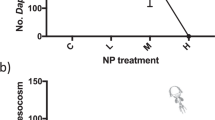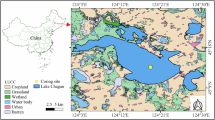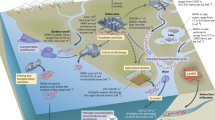Abstract
Freshwater ecosystems face numerous pressures including climate-induced warming, eutrophication and contaminants such as nanoplastics (NPs), which have emerged as a major environmental concern. Despite evidence of harmful effects on freshwater biota, critical knowledge gaps persist regarding the fate and impacts of NP fate and impacts in natural aquatic systems. Here we conducted a 28-day mesocosm experiment in freshwater pond communities, investigating polystyrene NP fate and effects under ambient, warmed and nutrient-enriched conditions. Using palladium-doped polystyrene NPs for precise tracking, we observed NP presence in all ecological compartments, mainly accumulating in biofilms (~97%). NP accumulation was influenced by both nutrient enrichment and warming, with warming significantly increasing NP concentration in fish guts. NPs decreased macroinvertebrate abundance, attributed to the decline in benthic caddisfly larvae, which graze on the NP-rich biofilm. This research represents a important advancement in our understanding of plastic pollution impacts, revealing the complex interplay between NP pollution and global environmental change factors in freshwater ecosystems.
This is a preview of subscription content, access via your institution
Access options
Subscribe to this journal
Receive 12 digital issues and online access to articles
$119.00 per year
only $9.92 per issue
Buy this article
- Purchase on SpringerLink
- Instant access to full article PDF
Prices may be subject to local taxes which are calculated during checkout






Similar content being viewed by others
Data availability
Statistical source data can be accessed via figshare at https://doi.org/10.6084/m9.figshare.26067691 (ref. 68).
References
Dudgeon, D. Multiple threats imperil freshwater biodiversity in the Anthropocene. Curr. Biol. 29, R960–R967 (2019).
Albert, J. S. et al. Scientists’ warning to humanity on the freshwater biodiversity crisis. Ambio 50, 85–94 (2021).
Reid, A. J. et al. Emerging threats and persistent conservation challenges for freshwater biodiversity. Biol. Rev. 94, 849–873 (2019).
Carpenter, S. R., Stanley, E. H. & Vander Zanden, M. J. State of the world’s freshwater ecosystems: physical, chemical, and biological changes. Annu. Rev. Environ. Resour. 36, 75–99 (2011).
Woodward, G., Perkins, D. M. & Brown, L. E. Climate change and freshwater ecosystems: impacts across multiple levels of organization. Phil. Trans. R. Soc. B 365, 2093–2106 (2010).
Mitrano, D. M., Wick, P. & Nowack, B. Placing nanoplastics in the context of global plastic pollution. Nat. Nanotechnol. 16, 491–500 (2021).
Ockenden, A., Tremblay, L. A., Dikareva, N. & Simon, K. S. Towards more ecologically relevant investigations of the impacts of microplastic pollution in freshwater ecosystems. Sci. Total Environ. 792, 148507 (2021).
Clark, N. J., Khan, F. R., Mitrano, D. M., Boyle, D. & Thompson, R. C. Demonstrating the translocation of nanoplastics across the fish intestine using palladium-doped polystyrene in a salmon gut-sac. Environ. Int. 159, 106994 (2022).
Koelmans, A. A. Proxies for nanoplastic. Nat. Nanotechnol. 14, 307–308 (2019).
Chae, Y., Kim, D., Kim, S. W. & An, Y.-J. Trophic transfer and individual impact of nano-sized polystyrene in a four-species freshwater food chain. Sci. Rep. 8, 284 (2018).
Liu, Z. et al. Polystyrene nanoplastic exposure induces immobilization, reproduction, and stress defense in the freshwater cladoceran Daphnia pulex. Chemosphere 215, 74–81 (2019).
Marchant, D. J., Martínez Rodríguez, A., Francelle, P., Jones, J. I. & Kratina, P. Contrasting the effects of microplastic types, concentrations and nutrient enrichment on freshwater communities and ecosystem functioning. Ecotoxicol. Environ. Saf. 255, 114834 (2023).
Martínez Rodríguez, A., Marchant, D. J., Francelle, P., Kratina, P. & Jones, J. I. Nutrient enrichment mediates the effect of biodegradable and conventional microplastics on macroinvertebrate communities. Environ. Pollut. 337, 122511 (2023).
Kumar, R. et al. Effect of physical characteristics and hydrodynamic conditions on transport and deposition of microplastics in riverine ecosystem. Water 13, 2710 (2021).
Noyes, P. D. et al. The toxicology of climate change: environmental contaminants in a warming world. Environ. Int. 35, 971–986 (2009).
Dijkstra, J. A. et al. Experimental and natural warming elevates mercury concentrations in estuarine fish. PLoS ONE 8, e58401 (2013).
Lyu, K., Cao, C., Li, D., Akbar, S. & Yang, Z. The thermal regime modifies the response of aquatic keystone species Daphnia to microplastics: evidence from population fitness, accumulation, histopathological analysis and candidate gene expression. Sci. Total Environ. 783, 147154 (2021).
Barneche, D. R. et al. Warming impairs trophic transfer efficiency in a long-term field experiment. Nature 592, 76–79 (2021).
Fryxell, D. C. & Palkovacs, E. P. Warming strengthens the ecological role of intraspecific variation in a predator. Copeia 105, 523–532 (2017).
Greig, H. S. et al. Warming, eutrophication, and predator loss amplify subsidies between aquatic and terrestrial ecosystems. Glob. Change Biol. 18, 504–514 (2012).
Bergmann, M. et al. High quantities of microplastic in Arctic deep-sea sediments from the HAUSGARTEN Observatory. Environ. Sci. Technol. 51, 11000–11010 (2017).
Holzer, M., Mitrano, D. M., Carles, L., Wagner, B. & Tlili, A. Important ecological processes are affected by the accumulation and trophic transfer of nanoplastics in a freshwater periphyton-grazer food chain. Environ. Sci. Nano 9, 2990–3003 (2022).
Koelmans, A. Integrated modelling of eutrophication and organic contaminant fate & effects in aquatic ecosystems. A review. Water Res. 35, 3517–3536 (2001).
Mitrano, D. M. et al. Synthesis of metal-doped nanoplastics and their utility to investigate fate and behaviour in complex environmental systems. Nat. Nanotechnol. 14, 362–368 (2019).
He, S. et al. Distribution, bioaccumulation, and trophic transfer of palladium-doped nanoplastics in a constructed freshwater ecosystem. Environ. Sci. Nano 9, 1353–1363 (2022).
Abell, J. M., Özkundakci, D. & Hamilton, D. P. Nitrogen and phosphorus limitation of phytoplankton growth in New Zealand lakes: implications for eutrophication control. Ecosystems 13, 966–977 (2010).
Materić, D. et al. Presence of nanoplastics in rural and remote surface waters. Environ. Res. Lett. 17, 054036 (2022).
Materić, D. et al. Nanoplastics measurements in northern and southern polar ice. Environ. Res. 208, 112741 (2022).
Xu, Y., Ou, Q., Jiao, M., Liu, G. & Van Der Hoek, J. P. Identification and quantification of nanoplastics in surface water and groundwater by pyrolysis gas chromatography–mass spectrometry. Environ. Sci. Technol. 56, 4988–4997 (2022).
Sullivan, G. L. et al. Detection of trace sub-micron (nano) plastics in water samples using pyrolysis-gas chromatography time of flight mass spectrometry (PY-GCToF). Chemosphere 249, 126179 (2020).
Skei, J. et al. Eutrophication and contaminants in aquatic ecosystems. AMBIO 29, 184–194 (2000).
Alimi, O. S., Farner Budarz, J., Hernandez, L. M. & Tufenkji, N. Microplastics and nanoplastics in aquatic environments: aggregation, deposition, and enhanced contaminant transport. Environ. Sci. Technol. 52, 1704–1724 (2018).
Peng, L. & Wang, Y. Sediment organic carbon dominates the heteroaggregation of suspended sediment and nanoplastics in natural and surfactant-polluted aquatic environments. J. Hazard. Mater. 440, 129802 (2022).
Lowry, G. V. et al. Long-term transformation and fate of manufactured Ag nanoparticles in a simulated large scale freshwater emergent wetland. Environ. Sci. Technol. 46, 7027–7036 (2012).
Tella, M. et al. Chronic dosing of a simulated pond ecosystem in indoor aquatic mesocosms: fate and transport of CeO 2 nanoparticles. Environ. Sci. Nano 2, 653–663 (2015).
Duchet, C. et al. Combined effects of climate warming and pharmaceuticals on a tri-trophic freshwater food web. Water Res. 250, 121053 (2024).
Scherer, C., Brennholt, N., Reifferscheid, G. & Wagner, M. Feeding type and development drive the ingestion of microplastics by freshwater invertebrates. Sci. Rep. 7, 17006 (2017).
Suren, A. M. & Lake, P. S. Edibility of fresh and decomposing macrophytes to three species of freshwater invertebrate herbivores. Hydrobiologia 178, 165–178 (1989).
McNeish, R. E. et al. Microplastic in riverine fish is connected to species traits. Sci. Rep. 8, 11639 (2018).
Bertoli, M. et al. Microplastics accumulation in functional feeding guilds and functional habit groups of freshwater macrobenthic invertebrates: novel insights in a riverine ecosystem. Sci. Total Environ. 804, 150207 (2022).
Clark, N. J., Khan, F. R., Crowther, C., Mitrano, D. M. & Thompson, R. C. Uptake, distribution and elimination of palladium-doped polystyrene nanoplastics in rainbow trout (Oncorhynchus mykiss) following dietary exposure. Sci. Total Environ. 854, 158765 (2023).
Moffett, E. R., Fryxell, D. C., Palkovacs, E. P., Kinnison, M. T. & Simon, K. S. Local adaptation reduces the metabolic cost of environmental warming. Ecology 99, 2318–2326 (2018).
Hasan, J. et al. Increase in temperature increases ingestion and toxicity of polyamide microplastics in Nile tilapia. Chemosphere 327, 138502 (2023).
Fryxell, D. C., Arnett, H. A., Apgar, T. M., Kinnison, M. T. & Palkovacs, E. P. Sex ratio variation shapes the ecological effects of a globally introduced freshwater fish. Proc. R. Soc. B 282, 20151970 (2015).
Gewurtz, S. B., Bhavsar, S. P. & Fletcher, R. Influence of fish size and sex on mercury/PCB concentration: importance for fish consumption advisories. Environ. Int. 37, 425–434 (2011).
Dong, H. et al. Tissue-specific accumulation, depuration, and effects of perfluorooctanoic acid on fish: influences of aqueous pH and sex. Sci. Total Environ. 861, 160567 (2023).
Yvon-Durocher, G., Montoya, J. M., Trimmer, M. & Woodward, G. Warming alters the size spectrum and shifts the distribution of biomass in freshwater ecosystems: warming alters community size structure. Glob. Change Biol. 17, 1681–1694 (2011).
Kratina, P., Greig, H. S., Thompson, P. L., Carvalho-Pereira, T. S. A. & Shurin, J. B. Warming modifies trophic cascades and eutrophication in experimental freshwater communities. Ecology 93, 1421–1430 (2012).
López-Rojo, N., Pérez, J., Alonso, A., Correa-Araneda, F. & Boyero, L. Microplastics have lethal and sublethal effects on stream invertebrates and affect stream ecosystem functioning. Environ. Pollut. 259, 113898 (2020).
Ockenden, A., Northcott, G. L., Tremblay, L. A. & Simon, K. S. Disentangling the influence of microplastics and their chemical additives on a model detritivore system. Environ. Pollut. 307, 119558 (2022).
Pyke, G. H. Plague minnow or mosquito fish? A review of the biology and impacts of introduced Gambusia species. Annu. Rev. Ecol. Evol. Syst. 39, 171–191 (2008).
Wallace, J. B. & Webster, J. R. The role of macroinvertebrates in stream ecosystem function. Annu. Rev. Entomol. 41, 115–139 (1996).
Redondo-Hasselerharm, P. E., Gort, G., Peeters, E. T. H. M. & Koelmans, A. A. Nano- and microplastics affect the composition of freshwater benthic communities in the long term. Sci. Adv. 6, eaay4054 (2020).
Stanković, J. et al. Exposure to a microplastic mixture is altering the life traits and is causing deformities in the non-biting midge Chironomus riparius Meigen (1804). Environ. Pollut. 262, 114248 (2020).
Klasios, N., Kim, J. O. & Tseng, M. No effect of realistic concentrations of polyester microplastic fibers on freshwater zooplankton communities. Environ. Toxicol. Chem. 43, 418–428 (2024).
Chang, M. et al. Changes in characteristics and risk of freshwater microplastics under global warming. Water Res. 260, 121960 (2024).
del Real, A. E. P. et al. Assessing implications of nanoplastics exposure to plants with advanced nanometrology techniques. J. Hazard. Mater. 430, 128356 (2022).
Pulido-Reyes, G. et al. Nanoplastics removal during drinking water treatment: laboratory- and pilot-scale experiments and modeling. J. Hazard. Mater. 436, 129011 (2022).
Frehland, S., Kaegi, R., Hufenus, R. & Mitrano, D. M. Long-term assessment of nanoplastic particle and microplastic fiber flux through a pilot wastewater treatment plant using metal-doped plastics. Water Res. 182, 115860 (2020).
Turner, A. & Filella, M. Hazardous metal additives in plastics and their environmental impacts. Environ. Int. 156, 106622 (2021).
IPCC Climate Change 2014: Synthesis Report (eds Pachauri, R. K. & Meyer, L. A.) (Cambridge Univ. Press, 2014).
Verburg, P., Hamill, K., Unwin, M. & Abell, J. Lake Water Quality in New Zealand 2010: Status and Trends NIWA Client Report: HAM2010-107 Hamilton (National Institute of Water & Atmospheric Research, 2010).
Standard Methods for the Analysis of Water and Wastewater (APHA, 2000).
Standard Operating Procedure for Zooplankton Analysis LG403, Revision 07 (EPA, 2016).
Mack, H. R., Conroy, J. D., Blocksom, K. A., Stein, R. A. & Ludsin, S. A. A comparative analysis of zooplankton field collection and sample enumeration methods: zooplankton sampling and counting methods. Limnol. Oceanogr. Methods 10, 41–53 (2012).
Von Schiller, D. S. Differential effects of preservation on the estimation of biomass of two common mayfly species. Arch. Hydrobiol. 164, 325–334 (2005).
Brooks, M. E. et al. glmmTMB balances speed and flexibility among packages for zero-inflated generalized linear mixed modeling. R J. 9, 378–400 (2017).
Ockenden, A., Mitrano, D. M., Kah, M., Tremblay, L. A. & Simon, K. S. Impacts of warming and nutrient enrichment on the fate and effects of nanoplastics in a freshwater food web. figshare https://doi.org/10.6084/m9.figshare.26067691 (2024).
Acknowledgements
Funding for this project came from the New Zealand Ministry of Business, Innovation and Employment Endeavour Programme (C03X1802) to K.S.S. and the Swiss National Science Foundation (PCEFP2 186856) to D.M.M. We are grateful to S. Morrow for technical assistance with the ICP-MS work and to L. Holding for assistance with field work.
Author information
Authors and Affiliations
Contributions
A.O. designed the study, collected and analysed the data and wrote the paper. D.M.M. provided the resources used in this study and edited the paper. M.K. edited the paper. L.A.T. edited the paper. K.S.S. designed the study, collected the data, acquired funding and edited the paper. All authors approved the final version of the paper.
Corresponding author
Ethics declarations
Competing interests
The authors declare no competing interests.
Peer review
Peer review information
Nature Water thanks Timothy Hoellein and the other, anonymous, reviewer(s) for their contribution to the peer review of this work.
Additional information
Publisher’s note Springer Nature remains neutral with regard to jurisdictional claims in published maps and institutional affiliations.
Supplementary information
Supplementary Information
Supplementary Figs. 1–7 and Tables 1–4.
Source data
Source Data Fig. 2
Statistical source data for nanoplastic concentrations in seston and biofilms.
Source Data Fig. 3
Statistical source data for nanoplastic concentrations in backswimmers and caddisfly larvae.
Source Data Fig. 4
Statistical source data for nanoplastic concentrations in fish guts and bodies.
Source Data Fig. 5
Statistical source data for ecological effects on all biological response variables.
Source Data Fig. 6
Statistical source data for caddisfly abundance.
Rights and permissions
Springer Nature or its licensor (e.g. a society or other partner) holds exclusive rights to this article under a publishing agreement with the author(s) or other rightsholder(s); author self-archiving of the accepted manuscript version of this article is solely governed by the terms of such publishing agreement and applicable law.
About this article
Cite this article
Ockenden, Α., Mitrano, D.M., Kah, M. et al. Impacts of warming and nutrient enrichment on the fate and effects of nanoplastics in a freshwater food web. Nat Water 2, 1207–1217 (2024). https://doi.org/10.1038/s44221-024-00334-2
Received:
Accepted:
Published:
Issue date:
DOI: https://doi.org/10.1038/s44221-024-00334-2
This article is cited by
-
Synergistic impact of temperature rises and ferric oxide nanoparticles on biochemical and oxidative stress biomarkers in Oreochromis niloticus: relevant environmental risk assessment under predicted global warming
Environmental Monitoring and Assessment (2025)
-
A quadrillion little pieces of plastic
Nature Water (2024)



